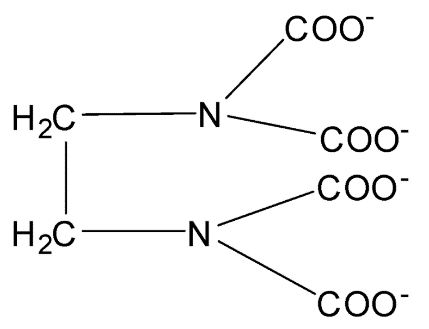
EDTA is a multidentate ligand. Its denticity or multiplicity is ………………………
Answer
532.5k+ views
Hint :Ligands are the donor atoms, molecules or anions which donate a pair of electrons to metal atoms or ions are called ligands. In EDTA there are four Oxygen atoms and two Nitrogen atoms. Nitrogen and oxygen both have lone pairs to coordinate with the central atom in the complex compound.
Complete Step By Step Answer:
We know that Denticity refers to the number of donor groups in a particular ligand that transfer lone pairs to the central atom and bind it in complex compounds.
In most of the cases, only a single atom in the ligand binds to the metal, then the denticity equals one, and the ligand is said to be monodentate or bidentate.
Ethylene diamine tetra acetate ions (EDTA) form a complex with metal ions in coordination compounds. Denticity refers to the number of donor groups that are attached to the ligand to participate in forming coordinate bonds with the complex compounds.
EDTA is a type of ligand in which donor atoms contain lone pairs of electrons and can donate electrons to positively charged central atom species to form complex compounds. EDTA is a multidentate ligand. Its denticity (multiplicity) is 6.
In EDTA, there are four Oxygen atoms and two Nitrogen atoms. Nitrogen and oxygen both have lone pairs to coordinate with the central atom in the complex compound. EDTA is also used extensively in the analysis of blood. It is an anticoagulant for blood samples in the field of medicine.
Structure of EDTA:

EDTA is a polydentate ligand have flexidentate character in which four Oxygen atoms and two Nitrogen atoms form coordinate bonds with the central metal atom or ion. Therefore, there are six donor atoms present in EDTA.
Hence, EDTA is a hexadentate ligand. Its denticity or multiplicity is 6.
Note :
The coordination compounds are of great importance and are widely present in minerals, plants and animals and are known to play many important functions in analytical chemistry, metallurgy, biological systems, industry and medicine. EDTA is used in treatment of lead poisoning. EDTA which is a hexadentate ligand also acts as tetradentate or pentadentate in certain complexes.
Complete Step By Step Answer:
We know that Denticity refers to the number of donor groups in a particular ligand that transfer lone pairs to the central atom and bind it in complex compounds.
In most of the cases, only a single atom in the ligand binds to the metal, then the denticity equals one, and the ligand is said to be monodentate or bidentate.
Ethylene diamine tetra acetate ions (EDTA) form a complex with metal ions in coordination compounds. Denticity refers to the number of donor groups that are attached to the ligand to participate in forming coordinate bonds with the complex compounds.
EDTA is a type of ligand in which donor atoms contain lone pairs of electrons and can donate electrons to positively charged central atom species to form complex compounds. EDTA is a multidentate ligand. Its denticity (multiplicity) is 6.
In EDTA, there are four Oxygen atoms and two Nitrogen atoms. Nitrogen and oxygen both have lone pairs to coordinate with the central atom in the complex compound. EDTA is also used extensively in the analysis of blood. It is an anticoagulant for blood samples in the field of medicine.
Structure of EDTA:

EDTA is a polydentate ligand have flexidentate character in which four Oxygen atoms and two Nitrogen atoms form coordinate bonds with the central metal atom or ion. Therefore, there are six donor atoms present in EDTA.
Hence, EDTA is a hexadentate ligand. Its denticity or multiplicity is 6.
Note :
The coordination compounds are of great importance and are widely present in minerals, plants and animals and are known to play many important functions in analytical chemistry, metallurgy, biological systems, industry and medicine. EDTA is used in treatment of lead poisoning. EDTA which is a hexadentate ligand also acts as tetradentate or pentadentate in certain complexes.
Recently Updated Pages
The number of solutions in x in 02pi for which sqrt class 12 maths CBSE

Write any two methods of preparation of phenol Give class 12 chemistry CBSE

Differentiate between action potential and resting class 12 biology CBSE

Two plane mirrors arranged at right angles to each class 12 physics CBSE

Which of the following molecules is are chiral A I class 12 chemistry CBSE

Name different types of neurons and give one function class 12 biology CBSE

Trending doubts
One Metric ton is equal to kg A 10000 B 1000 C 100 class 11 physics CBSE

Explain zero factorial class 11 maths CBSE

What is 1s 2s 2p 3s 3p class 11 chemistry CBSE

Discuss the various forms of bacteria class 11 biology CBSE

State the laws of reflection of light

Difference Between Prokaryotic Cells and Eukaryotic Cells




